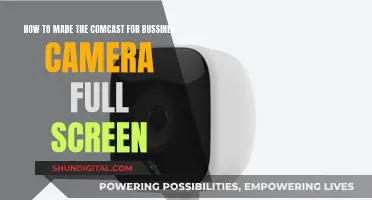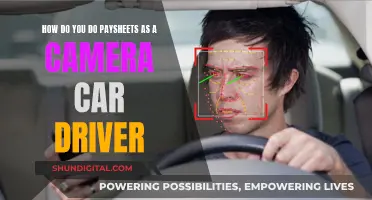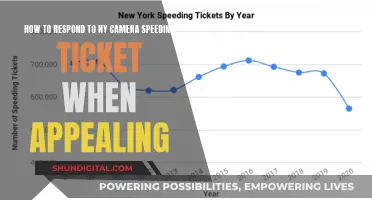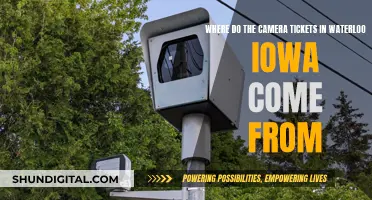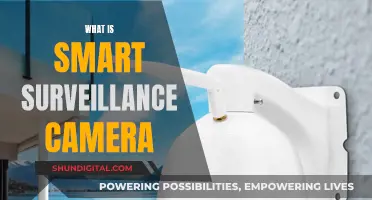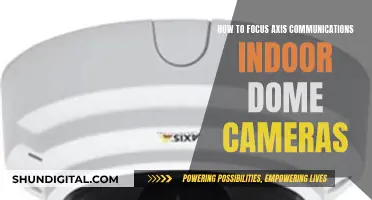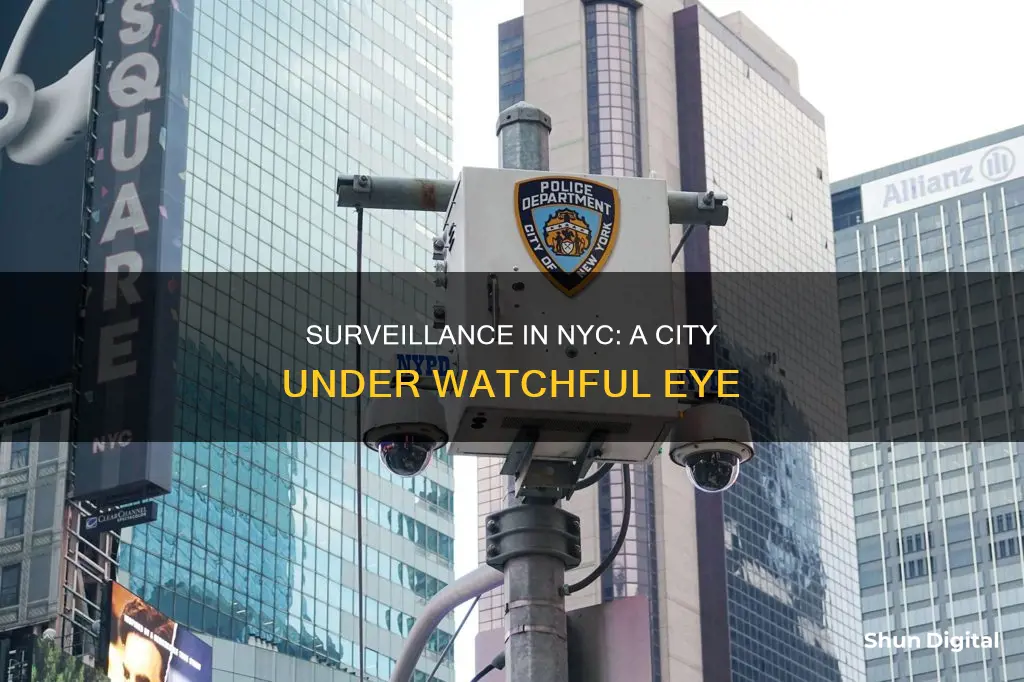
New York City is one of the most surveilled places in the world. The New York City Police Department (NYPD) has access to tens of thousands of surveillance cameras across the city, with estimates ranging from 15,000 to 18,000. These cameras are used for a range of purposes, including crime prevention, counter-terrorism, and the monitoring of political demonstrations and entire ethnic and religious groups. The NYPD has been criticised for its extensive use of surveillance, particularly in light of the fact that these cameras are often used in conjunction with controversial facial recognition technology.
What You'll Learn

The NYPD uses the Domain Awareness System (DAS) to monitor NYC
The NYPD uses the Domain Awareness System (DAS) to monitor New York City. DAS is the largest digital surveillance system in the world and was developed in partnership with Microsoft. The system is connected to 18,000 CCTV cameras, with some sources placing the number at 15,000. The cameras are owned by either the NYPD or private entities and are used to generate an aggregate citywide video stream. DAS also has access to data from billions of license plate readings, 911 calls, criminal databases, and terrorist databases.
The initial cost of development was $350 million, funded by Federal Homeland Security grants. The software is licensed out to other cities, with New York City receiving 30% of the profits. The system is overseen by the NYPD's counterterrorism bureau.
DAS allows the NYPD to track surveillance targets and gain detailed information about them. For example, officers can search for individuals based on physical characteristics such as shirt color, and the system will return live video feeds of all matching individuals within a given region. The system also employs machine learning algorithms to detect suspicious behaviour, such as unattended bags, and alert officers.
DAS has been the subject of criticism and concerns over privacy and civil rights violations. The system blurs the lines of accountability by staffing its headquarters with both police and private stakeholders. There are also concerns that the system could be used for racial profiling, given the NYPD's history of discrimination and surveillance of ethnic and religious groups.
Despite the concerns, there is substantial public and governmental support for the use of new technologies to detect terrorist and criminal activities. Proponents argue that systems like DAS enhance public safety and can help prevent terrorist attacks and provide evidence for criminal cases.
Fight Speeding Tickets: Know Your Rights, Louisiana
You may want to see also

Amnesty International mapped over 15,000 NYPD cameras
Amnesty International, a human rights organization, has released a report detailing the vast network of surveillance cameras in New York City. The report, titled "Surveillance City: NYPD Can Use More Than 15,000 Cameras to Track People Using Facial Recognition in Manhattan, Bronx, and Brooklyn," reveals that the New York City Police Department (NYPD) has access to over 15,000 surveillance cameras that can be used for routine monitoring and facial recognition searches. This network of cameras, combined with invasive facial recognition software, gives the NYPD the ability to track individuals across the city, raising serious concerns about privacy and civil liberties.
The Amnesty International report is the result of a comprehensive investigation conducted by thousands of volunteers from around the world. The volunteers tagged over 15,000 surveillance cameras at intersections across three of New York City's five boroughs: Manhattan (3,590 cameras), Brooklyn (8,220 cameras), and the Bronx (3,470 cameras). These three boroughs account for almost half of the intersections in the city, covering a vast surface area.
The report highlights the potential for abuse of this technology, particularly in majority non-white neighborhoods. East New York in Brooklyn has been identified as the most surveilled neighborhood, with 577 cameras found within less than 2 square miles. This area has a high proportion of Black and Hispanic residents, according to census data. The clustering of cameras in majority non-white neighborhoods raises concerns about racial profiling and discriminatory policing.
Facial recognition technology has been found to perform less accurately on darker-skinned individuals, and there is a risk of misidentification and false arrests. The NYPD has a history of controversial surveillance activities, including the monitoring of political demonstrations, activities of specific ethnic and religious groups, and even entire communities. The combination of extensive camera networks and facial recognition technology enhances the NYPD's power to conduct covert policing and track individuals' movements across the city.
Amnesty International's investigation also revealed that the NYPD has used facial recognition technology in 22,000 cases since 2017, with half of those cases occurring in 2019 alone. The NYPD has access to a large database of faces, often scraped from social media without users' knowledge or consent. This database enables the department to track individuals' faces as they move through the city, raising serious concerns about the right to privacy and freedom of peaceful assembly.
The report and accompanying videos are part of Amnesty International's #BantheScan campaign. The organization is urging city officials to ban the use of facial recognition technology by the police, citing the potential for misuse and the amplification of racist policing practices. The report's findings underscore the need for greater transparency and accountability in the use of surveillance technology by law enforcement agencies.
Focus Camera: What is Rack Focus?
You may want to see also

The NYPD has used facial recognition technology since 2011
The New York City Police Department (NYPD) has been using surveillance technology to monitor public activity in New York City for several years. In 2021, Amnesty International, a human rights organization, mapped the locations of over 15,000 cameras used by the NYPD for routine surveillance and facial recognition searches. The cameras are often placed on top of buildings, on street lights, and at intersections, capturing the movements of nearly half of the city's residents.
The NYPD has a dedicated unit of officers known as the Facial Identification Section (FIS) that has been using facial recognition technology since 2011. This technology is used to compare images taken from surveillance cameras with photos like mug shots, juvenile arrest photos, and pistol permits. Between 2011 and 2017, the NYPD made over 2,800 arrests based on facial recognition matches.
The use of facial recognition technology by the NYPD has been controversial. Critics argue that it invades personal privacy and disproportionately targets people of color. There have been concerns about the accuracy of the technology, especially when used on darker-skinned individuals. In 2019, a study found that facial recognition programs tended to be less accurate when analyzing Black or Asian individuals.
The NYPD has been accused of misleading the public about its use of facial recognition technology. Emails obtained through freedom of information requests revealed a close relationship between the NYPD and Clearview AI, a company that provides facial recognition software. The emails showed that many officers had access to Clearview AI and used it in live investigations, contrary to the NYPD's previous statements.
Despite the concerns and criticism, the NYPD continues to defend its use of facial recognition technology, stating that it helps solve crimes and is used in combination with human analysis. The debate around the use of this technology in New York City and other cities across the country continues, with some calling for more regulation and transparency from law enforcement agencies.
Sigma Dealer Focus Camera: Certified and Trustworthy
You may want to see also

Surveillance cameras are present in NYC subway cars
The New York City subway system is set to install surveillance cameras in every train car by 2025. The move, announced by Governor Kathy Hochul in 2022, is aimed at increasing rider confidence in the subway system's safety and addressing the issue of lagging ridership rates, which have yet to recover to pre-pandemic levels. The installation of these cameras will mean that the entire New York City subway fleet will be outfitted with two cameras in each train car, enhancing security coverage and deterring crime.
The decision to implement surveillance cameras in subway cars has sparked concerns among privacy advocates, who worry about the potential for increased surveillance without a guaranteed improvement in safety. Albert Fox Cahn, the founder of the Surveillance Technology Oversight Project (STOP), expressed his criticism, calling it a "terrible surveillance PR stunt just to boost ridership." The cameras in subway cars will record footage onto a memory card, which can be accessed by law enforcement agencies for solving crimes.
The addition of cameras in subway cars complements the existing network of cameras in subway stations, strengthening the overall security measures of the New York City subway system. This comprehensive surveillance system, including over 18,000 CCTV cameras across New York City, is managed by the New York City Police Department (NYPD) through their Domain Awareness System (DAS). The NYPD has credited their surveillance infrastructure for preventing terrorist attacks and providing evidence for criminal cases.
While the presence of surveillance cameras in the subway cars aims to address safety concerns and deter criminal activity, it also raises questions about the balance between public safety and individual privacy. The use of advanced technologies, such as facial recognition software, further complicates the discussion around ethical boundaries and the potential for misuse or abuse of personal data.
The installation of surveillance cameras in New York City subway cars is part of a broader initiative to enhance security and restore confidence in the city's subway system. While officials promote these measures as necessary for public safety, privacy advocates continue to voice their concerns about the potential implications for civil liberties and the impact on marginalized communities.
Single Shooting Mode: Capturing Unique Camera Moments
You may want to see also

The most surveilled neighbourhood in NYC is East New York, Brooklyn
New York City is one of the most surveilled cities in the world, with over 15,000 cameras in three of its five boroughs. The New York City Police Department (NYPD) uses these cameras for routine surveillance and facial recognition searches. The NYPD has used facial recognition technology in 22,000 cases since 2017, with half of those cases occurring in 2019 alone.
The most surveilled neighbourhood in all of New York City is East New York in Brooklyn. According to the latest census data, this area is 54.4% Black, 30% Hispanic, and 8.4% White. Amnesty International found 577 cameras in less than 2 square miles in this neighbourhood, which amounts to an alarming number of cameras in such a small area.
The high number of cameras in East New York, Brooklyn is particularly concerning given that facial recognition technology often performs less accurately on darker-skinned people than lighter-skinned people. This means that the residents of East New York, the majority of whom are people of colour, are at an increased risk of misidentification and wrongful arrest.
The NYPD has defended its use of facial recognition technology, stating that it is only used to investigate "a suspect or suspects related to the investigation of a particular crime" and that no one has ever been arrested solely on the basis of a facial recognition match. However, critics argue that the use of this technology infringes on the privacy and civil liberties of New Yorkers, especially those from marginalized communities.
The extensive network of surveillance cameras in New York City is just one example of the city's history of surveillance. The NYPD has a long track record of surveillance activities targeting various groups, including political demonstrations, activities, and protests, as well as entire ethnic and religious groups. The department has also been criticized for its use of undercover officers to infiltrate and monitor activist and protest groups.
Charging Your 360 Fly Camera: A Quick Guide
You may want to see also
Frequently asked questions
According to a survey by Amnesty International, there are more than 15,000 surveillance cameras in New York City.
Amnesty International, a human rights organization, conducted the survey with the help of volunteers.
The New York City Police Department (NYPD) uses these cameras for routine surveillance and facial recognition searches. The data is used in the department's day-to-day operations, including counter-terrorism investigations and resolving domestic violence complaints.
The cameras are spread across the city, with a higher concentration in certain neighborhoods. Brooklyn is reported to be the most surveilled borough, with over 8,000 cameras. East New York, Brooklyn, is considered the most monitored neighborhood, with 577 cameras within less than 2 square miles.


